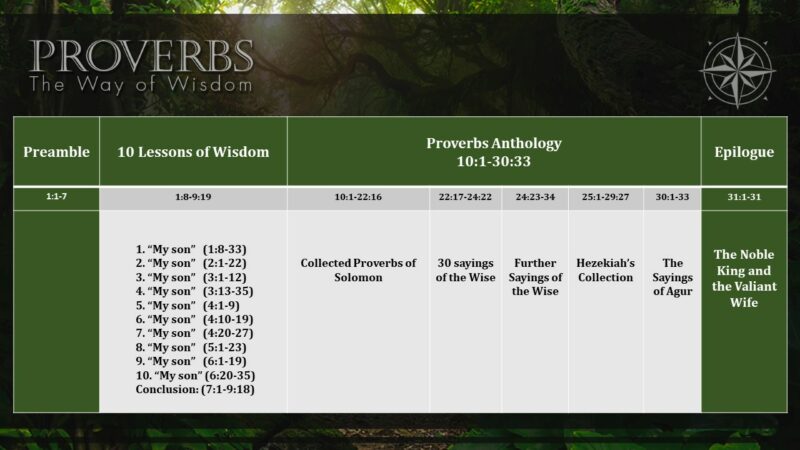
This summer we are preaching through the book of Proverbs in our sermon series called, “The Way of Wisdom.” We are excited to store up God’s wisdom for the practical areas of our lives. Here is some background information on this amazing book as we get started in terms of its author, purpose and overall structure:
Who is the Author?
The author was primarily Solomon. 1 Kings 3-4 describes him as supernaturally gifted in knowing all about many areas (such as zoology, musicology, botany, and entomology). He was the wisest person in the ancient world and the fountainhead of Israel’s wisdom literature. Proverbs is not all written by him personally, but he is where the wisdom tradition began. (a)
What is the Purpose of Proverbs?
Originally, this book was written as a manual for training the future kings of Israel. This is why it says “my son” over and over again (especially in chapters 1-9), as it was for preparing diligent and honest men to serve the royal bureaucracy. Eventually, its purpose was broadened. It became a handbook to raise up an entire generation of people with wisdom, studying under wise teachers and mentors.
“It’s goal is to describe and instill wisdom in God’s people a wisdom that is founded in the fear of the Lord and that works out covenant life in the practical details of everyday situations and relationships.” (b)
How do we interpret the Proverbs?
This book must be interpreted according to its genre. Proverbs are general principles and patterns, not promises or guarantees. A “proverb” is “a short, pregnant sentence or phrase whose meaning is applicable in many situations, with imagery or striking verbal form to assist the memory.” (c) The Expositor’s Bible Commentary says, “A proverb may then be described as an object lesson based on or using some comparison or analogy. It may be a short saying that provides a general truth.” Proverbs are “generalizations about the way ‘the world wags’ to awaken the mind and train the judgment.” And as having “shortness, sense, and salt.” (d)
Here are some key questions to ask to unlock the deeper meaning of a proverb:
1. What virtue does this proverb commend?
2. What vice does it hold up for disapproval?
3. What value does it affirm?
What are some other “Unique” features of Proverbs?
1. The Two Roads:
There are 10 lessons in the beginning describing two roads, the way of wisdom vs. the way of folly. This is a fork. We are all here at any given moment of any given day.
2. The Personification of Wisdom:
Wisdom is personified as a woman. Folly is also personified as a woman, an adultress, with both of them calling out to us at any moment in time. Wisdom calls us to virtue, integrity and generosity and brings honor, life, safety, exaltation, success and peace; whereas Folly calls us to selfishness, evil and pride and brings dishonor, calamity, shame, turmoil, ruin, and death. There are four poems from Lady Wisdom (1:20-33, 3:13-20; ch 8, ch 9). Some see chapter 31 as an appendix personifying wisdom as the ideal wife for the king.
3. Christ in the Book of Proverbs:
Jesus Christ is the ultimate personification of wisdom, in whom all the treasures of wisdom and knowledge are hidden (Col 2:3). The writer of Proverbs asks this prophetic question,
“Who has gone up to heaven and come down? Whose hands have gathered up the wind? Who has wrapped up the waters in a cloak? Who has established all the ends of the earth? What is his name, and what is the name of his son? Surely you know!” (Prov 30:4)
Jesus claimed to be ultimate source of Wisdom: “The Queen of the South will rise at the judgment with this generation and condemn it; for she came from the ends of the earth to listen to Solomon’s wisdom, and now something greater than Solomon is here.” (Matt 12:42 NIV). Jesus is the ultimate Sage / King and the quintessential wise “son.”
What is the Structure of Proverbs?
The book of Proverbs divides into 4 main sections. It begins with a preamble (1:1-7), and is followed by 10 lessons of wisdom. (1:8-9:18), which are “didactic poems.” The words “My Son” begins each lesson. The main body of Proverbs is the anthology (Ch 10-30, aka, “Proverbs proper”). This is a collection of those little pithy proverbs, usually one every verse and there’s hundreds of them which apply to every area of life: marriage, work, family, friendship, money, anger, poverty, alcohol, debt, speech, etc. etc. etc. Proverbs concludes with an epilogue (Ch 31), including an acrostic poem.

Outline of Proverbs:
I. Preamble (1:1-7)
II. 10 Lessons of Wisdom (1:8-9:18)
a. Lesson 1 (1:8-33)
b. Lesson 2 (2:1-22)
c. Lesson 3 (3:1-12)
d. Lesson 4 (3:13-35)
e. Lesson 5 (4:1-9)
f. Lesson 6 (4:10-19)
g. Lesson 7 (4:20-27)
h. Lesson 8 (5:1-23)
i. Lesson 9 (6:1-19)
j. Lesson 10 (6:20-35)
k. Conclusion: (7:1-9:18)
III. Proverbs Anthology (10:1-30:33)
a. The Collected Proverbs of Solomon (10:1-22:16)
i. Proverbs Contrasting Righteous and Wicked (10:1-15:29)
ii. Proverbs about the Lord and His King (15:30-22:22)
b. Other Collections of Proverbs
i. 30 Sayings of the Wise (22:17-24:22)
ii. Further saying of the Wise (24:23-34)
iii. Collection of Hezekiah’s men (25:1-29:27)
iv. The Saying of Agur (30:1-33)
IV. Epilogue – The Sayings of King Lemuel (Prov 31:1-31)
a. The Noble King (31:1-9)
b. The Valiant Wife (31:10-31), an acrostic poem.
Challenge:
During this series, we want to challenge you to read the book of Proverbs. One chapter per day. Stay tuned for more posts on this amazing source of God’s wisdom.
To watch our sermons in this series, go here.
Here are some recommended resources on the book of Proverbs:
- Devotional: Tim Keller, “God’s Wisdom for Navigating Life: A Year of Daily Devotions in the Book of Proverbs.” (2017)
- Commentaries:
- Derek Kidner, “The Wisdom of Proverbs, Job and Ecclesiastes.” (1985)
- Bruce Waltke, “The Book of Proverbs.” (Vol 1 and 2) NICOT. (1994).
- David A. Hubberd. “Proverbs.” The Preacher’s Commentary. Vol 15. (1989)
References:
(a) A note about authorship: As a cultural backgrounds point, the antiquity of Egyptian literature leads one to have no trouble accepting the authorship of Solomon. The “Instruction of Amenemope” has a very similar structure with main title, prologue and main text as a collection from the same time period. There may even be a direct quote of Amenemope in Proverbs 22:20 in the “thirty sayings.” For more on this go here. It is therefore reasonable to render Solomonic authorship to most of Proverbs. Those who question Solomon’s authorship inconsistently regard attributions to Hezekiah, Agur, and Lemuel as authentic. Other collections of Proverbs inside the book were added later and the book had a final editor.
(b) Definition taken from the ESV Study Bible (p 1130)
(c) Scott, The Way of Wisdom in the OT, (1971) p 22.
(d) Scott, The Way of Wisdom in the OT, (1971) p 58.




